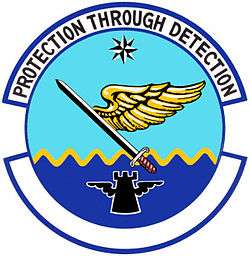960th Airborne Air Control Squadron
| 960th Airborne Air Control Squadron | |
|---|---|
|
960th Airborne Air Control Squadron Patch | |
| Active |
15 January 1941 – 27 December 1945 8 March 1955 – 31 July 1969 1 September 1979 – 1 July 1992 1 March 2001 – Present |
| Country | United States |
| Branch | United States Air Force |
| Type | Airborne Command and Control |
| Part of |
Air Combat Command 12th Air Force 552d Air Control Wing 552d Operations Group |
| Garrison/HQ | Tinker Air Force Base |
| Decorations |
|
The 960th Airborne Air Control Squadron (960 AACS) is part of the 552d Air Control Wing at Tinker Air Force Base, Oklahoma. It operates the E-3 Sentry aircraft conducting airborne command and control missions.
Mission
Provide the Combat Air Force with airborne systems and personnel for surveillance, warning and control of strategic, tactical, and special mission forces.[1]
History
Established as a pre-World War II B-17 Flying Fortress bomber squadron, activated at Fort Douglas, Utah in January 1941. After training, was assigned to Gieger Field, Washington as part of the Army Air Corps Northwest Air District in July. After the Pearl Harbor Attack, the squadron initially flew antisubmarine patrols along the Northwest Pacific Coastline.
Reassigned to II Bomber Command at Davis-Monthan Field, Arizona in February 1942 where the parent group became a B-17 Operational Training (OTU) unit for newly formed heavy bomb groups; operated as a training squadron for new and later replacement bomber crew members. Inactivated on 1 April 1944 with the end of heavy bomber training.[2]
B-29 Superfortress operations against Japan
Re-designated on 1 April 1944 as a B-29 Superfortress Very Heavy bombardment squadron. When training was completed moved to North Field Guam in the Mariana Islands of the Central Pacific Area in January 1945 and assigned to XXI Bomber Command, Twentieth Air Force. Its mission was the strategic bombardment of the Japanese Home Islands and the destruction of its war-making capability.
Flew "shakedown" missions against Japanese targets on Moen Island, Truk, and other points in the Carolines and Marianas. The squadron began combat missions over Japan on 25 February 1945 with a firebombing mission over Northeast Tokyo. The squadron continued to participate in wide area firebombing attack, but the first ten-day blitz resulting in the Army Air Forces running out of incendiary bombs. Until then the squadron flew conventional strategic bombing missions using high explosive bombs.
The squadron continued attacking urban areas with incendiary raids until the end of the war in August 1945, attacking major Japanese cities, causing massive destruction of urbanized areas. Also conducted raids against strategic objectives, bombing aircraft factories, chemical plants, oil refineries, and other targets in Japan. The squadron flew its last combat missions on 14 August when hostilities ended. Afterwards, its B 29s carried relief supplies to Allied prisoner of war camps in Japan and Manchuria
Squadron remained in Western Pacific, although largely demobilized in the fall of 1945. Some aircraft scrapped on Tinian; others flown to storage depots in the United States. Inactivated as part of Army Service forces at the end of 1945.[2]
Air Defense Command
It provided early warning radar surveillance along the East Coast of the United States from, 1955-1969. It supported two deployed rotating aircraft with crews in Iceland to provide early detection of Soviet aircraft flying between Iceland and Greenland from, 1979-1992.[2]
Operations and decorations
- Combat Operations: Conducted bombardment missions against Japan, c. 6Apr-14 Aug 1945. Supported two deployed rotating aircraft with crews in Iceland to provide early detection of Soviet aircraft flying between Iceland and Greenland, 1979-1992.
- Campaigns: World War II: Western Pacific; Air Offensive, Japan.
- Decorations: Distinguished Unit Citations: Japan, 10 May 1945; Tokyo and Yokohama, Japan, 23–29 May 1945. Air Force Outstanding Unit Awards: 1 Jul 1957-31 Oct 1958; [1 Sep 1979]-30 Jun 1980; 1 Jul 1982-30 Jun 1984; 1 Apr 1987-31 Mar 1989; 1 Dec 1989-1 Dec 1991.
Lineage
- Constituted 60th Bombardment Squadron (Heavy) on 20 Nov 1940
- Activated on 15 Jan 1941
- Inactivated on 1 Apr 1944
- Re-designated 60th Bombardment Squadron, Very Heavy, and activated, on 1 Apr 1944
- Inactivated on 27 Dec 1945
- Consolidated (19 Sep 1985) with 960th Airborne Early Warning and Control Squadron, which was constituted on 8 Dec 1954
- Activated on 8 Mar 1955
- Inactivated on 31 Jul 1969
- Re-designated 960th Airborne Warning and Control Support Squadron on 31 Jul 1979
- Activated on 1 Sep 1979
- Re-designated 960th Airborne Warning and Control Squadron on 1 Jan 1982
- Inactivated on 1 Jul 1992
- Re-designated 960th Airborne Air Control Squadron on 26 Jan 2001
- Activated on 1 Mar 2001.[2]
Assignments
- 39th Bombardment Group, 15 Jan 1941-1 Apr 1944; 1 Apr 1944-27 Dec 1945
- 551st Airborne Early Warning and Control Wing, 8 Mar 1955-31 Jul 1969
- 552d Airborne Warning and Control Wing (later, 552d Airborne Warning and Control Division), 1 Sep 1979
- 28th Air Division, 1 Apr 1985
- 552d Operations Group, 29 May-1 July 1992; 1 Mar 2001–Present[2]
Stations
|
|
Aircraft
|
|
 | |  |
| B-17 Flying Fortress (1941–1942) | B-25 Mitchell (1941) | B-24 Liberator (1942–1944) |
 |  |  |
| B-29 Superfortress (1944–1945) | RC/EC-121 Constellation (1955–1969) | E-3 Sentry (1979–1992, since 2001) |
References
![]() This article incorporates public domain material from the Air Force Historical Research Agency website http://www.afhra.af.mil/.
This article incorporates public domain material from the Air Force Historical Research Agency website http://www.afhra.af.mil/.
- ↑ 552 OG Fact Sheet Archived 22 July 2011 at the Wayback Machine.
- 1 2 3 4 5 6 7 AFHRA 960 AACS Page
- Maurer, Maurer, ed. (1982) [1969]. Combat Squadrons of the Air Force, World War II (PDF) (reprint ed.). Washington, DC: Office of Air Force History. ISBN 0-405-12194-6. LCCN 70605402. OCLC 72556.
- AFHRA 960th Airborne Air Control Squadron History
- 552d Operations Group Fact Sheet



.png)